“Can you picture Richard Branson dreaming of a high Net Promoter® Score when launching the Virgin Group?
Did you ever hear Elon Musk touting Customer Effort Score as the motivation behind new products?
Or Mother Teresa discussing her work in terms of CSAT?
The right metrics are important, for sure.
But vision they aren’t.
Metrics don’t win hearts and loyalties.”
– Brad Cleveland, Author of the book Leading the Customer Experience,
Hearts and loyalties are won by great leadership. Great leadership is the most powerful leverage you can have in your CX program, yet it is the least common feature in most programs. Why is that?
In the Global State of Customer Experience study, we can see that only 15% of programs have “visibility of all or most CX benefits the program generates,” and they go on to find that “close to 60% of leaders urge to prove CX ROI”. These results mean that we mostly rely on the assumption that CX is a good business practice rather than knowing it.
In more than 17 years of implementing CX programs, I have seen a common pattern: CX Teams chasing “quick wins” to convince Leadership Teams they should support CX initiatives. This sounds like my child saying “Dad healthy eating is good for me and I will prove it by losing 3 pounds in a week. If I do so, would you help me with a proper nutritionist?” As ridiculous as it sounds, it happens a lot in CX programs.
In most cases, this pattern is a self-fulfilling prophecy. In search of “low hanging fruit”, CX Teams, with great determination and goodwill, tie CX metrics to balanced scorecards, ignite client-centric cultural programs and hand over the voice of the customer results to silos expecting action plans in return. What normally happens is that people feel CX KPIs are ambiguous, not reliable, and utterly unfair, cultural programs drain precious resources with shy results and action plans attack local symptoms rather than systemic causes.
Whose fault is this?
Well, leadership is there to ensure CX is understandable to everybody in the business, that is, describe how customer perceptions propel economic behaviors that accelerate positive dynamics in the business model.
For example, suppose we are an airline with low-cost, reliable flights and a friendly staff value proposition. In that case, CX will mean clients know they can’t expect inflight amenities or baggage transfer, but they will experience efficiency, smiles, and lots of help. In return, frequent fliers will rely on self-service, fly more, and bring economies of scale and low cost to serve. The result of these dynamics is high aircraft utilization, low-cost operations, frequent and timely flights. Value for the entire system: both clients and company.
But leadership is normally too busy to track down these dynamics and CX is not doing it, so we return to our start line: Leadership doesn’t know how CX is actually good business and support is mediocre. Let´s get out of this loop, fast and for good.
First, figure out the “CX Business Model”, then “CX ROI” will be quite obvious, and C-Level Sponsorship will inevitably happen.
Back to basics with 3 questions:
- What is your business model?
- Which customer economic behaviors are critical for your success?
- How will you pay for that extraordinary and strategically focused CX?
What is your CX business model?
The most fundamental of all management questions is “What business are you in?” (This question is highly regarded to Peter Drucker. For a great review, see: https://medium.com/@Craig.Foster/drucker-s-essential-question-what-business-are-you-in-5decad8c9c8)
Please do not default on what you do, like “we are in the shoe/banking/airline/coffee / you name it business” nor on generic answers like “we are in the service business.” Actually, those definitions will put you side by side with 99.9% of businesses and what you want is CX differentiation.
One great start is the ultra-famous Business Model Canvas® from Osterwalder. At the center lies our value proposition, far-right our segments – What we do for whom? The only correct answer to this question comes from the voice of your customers. It’s not about what you say, it’s about what they value and perceive.
Four questions to ask here are:
i. In your own words, what do we do for you?
ii. If you were to recommend us, what would you say to convince someone to buy/do business with us?
iii. What was your situation before buying/working with us and what transformation happened since we appeared in your life?
iv. What do we do way better than our competition?
The answers to these questions will shed lots of light on the definition of our value proposition.
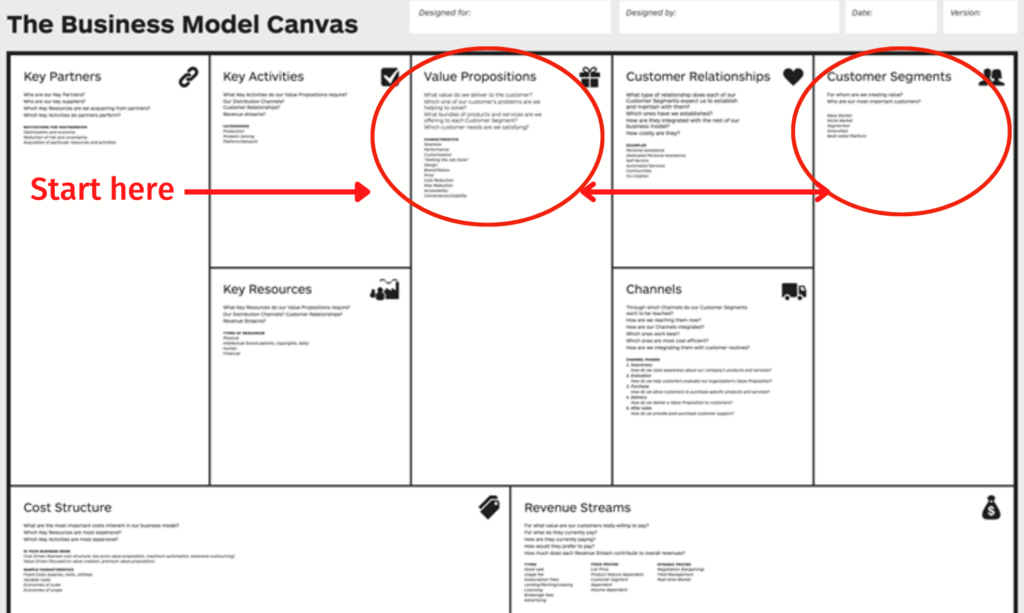
From there, we connect customer relationships and channels. In other words, how do we deliver our value proposition?
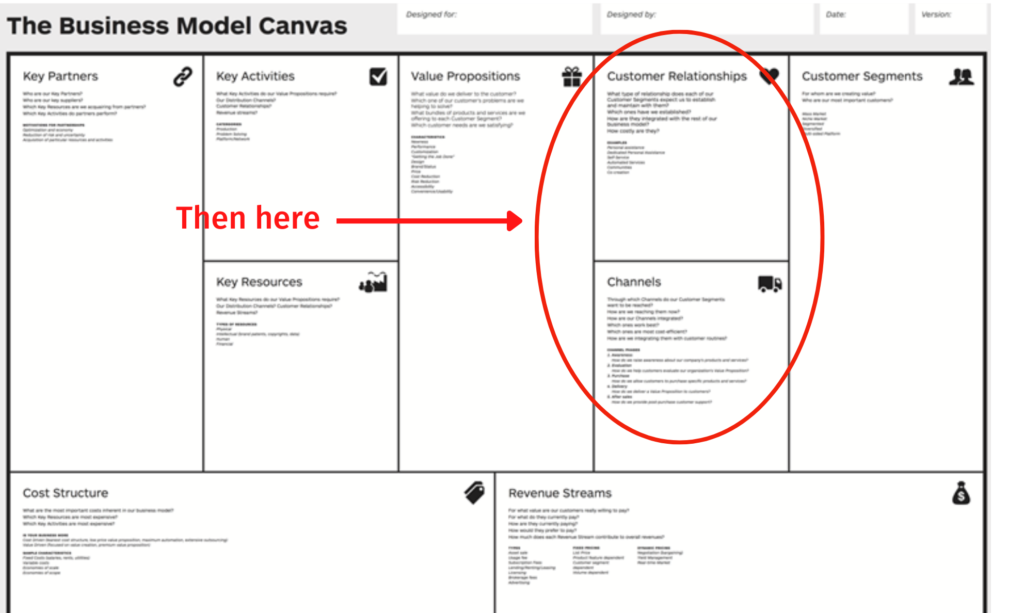
Again, it is not about us; it’s about what our clients say: What kind of relationship do they expect? We work a lot in Financial Services where a company can have 10 million clients, and all of them will likely expect personalized service; who wouldn’t like a personal banker? It is easy to think, “we can’t deliver personal service, but we can make self-service easy.”
This is correct but misses the point. Remember, we are trying to unearth CX dynamics that bring our business model to life or build a business model to life thinking in terms of CX. The real question is: How should we accompany our clients along their life journey, so we help them be successful with us and make a good business out of it?
To be truly customer-centric, we have to define “Revenue Streams” in the context of “Customer Economic Behaviors”,
i. Initial purchase
ii. Continual purchase
iii. Cross and up purchasing
iv. Active recommendation
v. Goodwill (like when your customer loves you so much they help with self-service tasks).
The logic behind these behaviors is that each of them brings money to the company.
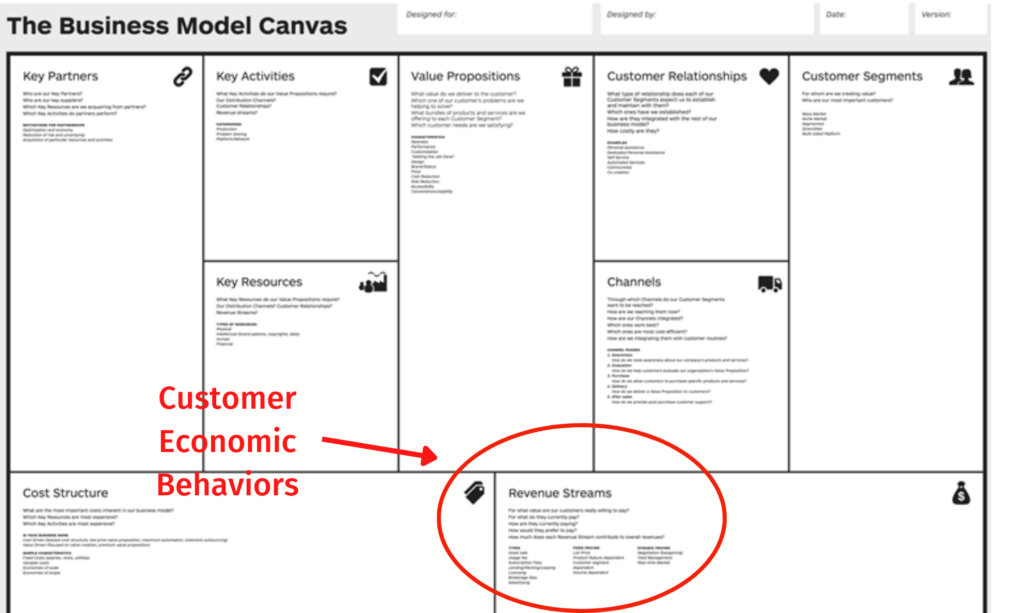
If we frame the question “What business are we in?” from the Customer Economic Behaviors and link it to value proposition delivery, we are in a great vantage point to define how we will make money by generating great experiences to move our clients from one behavior to the next one.
Seasoned SaaS companies have used this principle quite well, tying operative KPIs to CX like “how long does it take us to deliver tangible value vs implementation costs vs. customer lifetime value”. They are in the business of adoption, where implementation is key, but continuous value delivery is king. And they know this costs money, so they better manage customer success effectiveness and ROI.
Key questions to ask here are:
1. What are the buying experiences that will accelerate customer acquisition?
2. What experiences should we deliver after the initial purchase to thrill clients to stay with us and buy more? How do we accompany their product and service adoption journey so they find incremental value?
3. How do we monetize durable relationships and lower our cost-to-serve?
It is tempting to answer “all of the above” but what is your priority right now? With which segments? Be very specific on how will CX do the job.
So much for the “right-side” of our CX business model; let’s move on to delivering our promises. What processes are absolutely critical to delivering your promise and fostering customer economic behaviors to monetize great customer experiences?
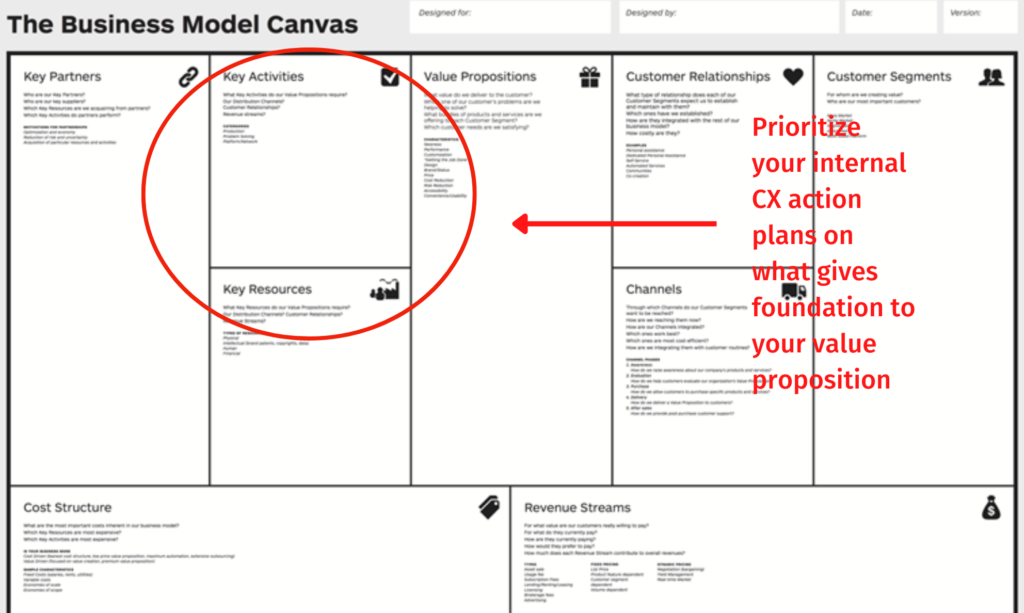
You will get lots of information from your voice of the customer initiatives but they can be mostly noise if we do not see them through the business model sunglasses.
Let’s say you use Net Promoter®; you will potentially get +100 key CX topics from detractors (We normally start with an in-depth inventory of negative comments and we normally have around 100 to 120 specific topics classified along the customer journey, products and service channels). The common practice is to start with the “most mentioned”, the ones that make 80% of negative comments. A more sophisticated practice is to run a regression analysis and build an Incidence vs. Impact matrix. All of this is necessary and if done well, it’s very shinny. That’s why you need sunglasses. You have to select the critical few from the trivial many, and the “left side” of your business model will help you do that.
Which of these complaint topics profoundly affect your ability to deliver your promise? Which of them inhibit key customer economic behaviors? This is the business conversation your CEO wants you to lead. (For a great reading on this see “What the CEO wants you to know: using Business Acumen to understand how your company really works” from Ram Charan. It is a gem of a very short, succinct and lovely business book every CX professional should read.)
I remember a B2B client we had; nearly 250 of their clients mentioned “poor sales attention” but only 7 geniuses mentioned, “sales reps lack enough time to have valuable visits”. We talked to them and decoded what a valuable visit is in their own words. We systematically applied those insights, removed barriers to “valuable visits,” and next year, our client was named “supplier of the year”. CX is not a numbers game, it’s a business strategy game.
Now is time to think about how you will pay for it.
One of the best CX strategy books is “Uncommon Service” by Frei and Morriss. They mention 4 inevitable truths of great CX:
- You can’t be good at everything
- Someone has to pay for it
- It’s not your employees’ fault
- You must manage your customers
If we look at these indisputable truths from the CX Business Model lens, we’ll see they are all tie together.
i. Your value proposition will determine key activities, processes, and partnerships, and bear in mind that the left side of your CX Business Model is finite. Therefore you can’t be good at everything. This is where you must pay undivided attention to the voice of your customers and your business model to make this tough decision right. Frei & Morriss make this point beautifully in their book: the laws of physics apply. Go ask an architect to build you a luxurious home in 6 months within a tight budget and see what happens. If she is kind enough not to laugh she might say “choose two out of three, I can build fast but costly, cheap but modest, or luxurious but costly AND slow”. Many managers think the laws of physics do not apply to them, and this is by far the number one root cause I have seen in CX strategy failures.
ii. Bringing that great experience to life will cost you money, resources, and focus. Someone has to pay for it. You better figure this out from your Revenue Streams (customer economic behaviors) vs. your Cost Structure.
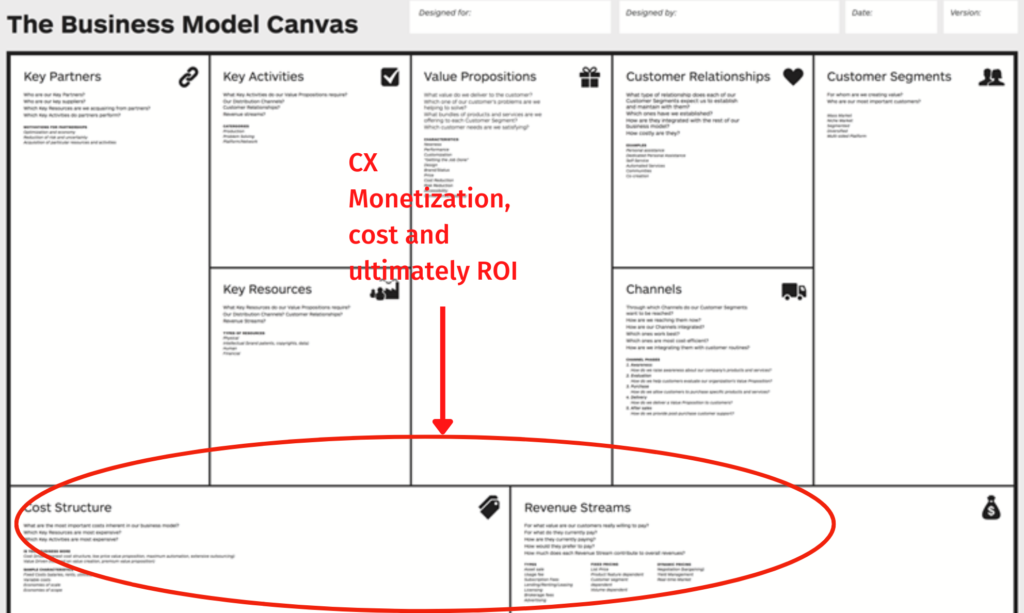
iii. Delivering your promise is all about managing your processes, not just your people. This is the reason why I am quite suspicious about “Customer Culture Programs”, I have seen a tendency in leaders to jump straight into getting the “Culture right”. Why not get the process right in firsthand? The critical ones. When you are diligent about aligning your processes to what customers value and relentlessly improve and manage them its inevitable that a Customer Culture emerges. Not the other way around. It’s not your employees’ fault; it’s your processes’ fault.
iv. You must manage your customers. Back to the far-right of our CX Business Model. Our customers perform many duties to be served, but we rarely acknowledge this, let alone manage it.
“Customers can wreak havoc on your operations. It’s what makes us hesitate when we hear “the customer is always right” or that the path to service excellence is to simply delight your clients. Performance can’t be sustained by placing customers on a pedestal and indulging their every desire. To create a system in which excellence is the norm, you need to manage your customers every bit as much as you manage your employees.”
And as mentioned in the book Uncommon Service by Frei & Morriss,
- Does your value proposition involve the role of your client?
- Do your key activities envision the customer role?
- Are you factoring in how your customers can decrease your cost-to-serve and how this can return in better conditions for them?
If I think about the above principles, I can only think that CX is not a romantic game. It’s a management game.
Finding the Leverage point in CX programs
To be effective, the above decisions normally pertain to the C-Level guys. But normally, they are too focused on nailing their internally defined KPIs. So, as a CX Expert, you must deeply understand your CX Business Model, make an informed argument of CX ROI, and then open business conversations as high as possible.
When CX is a bilingual conversation, our customers say in the context of our business. Then you start finding the real leverage.
For more on CX that produces business results, please find me at:

